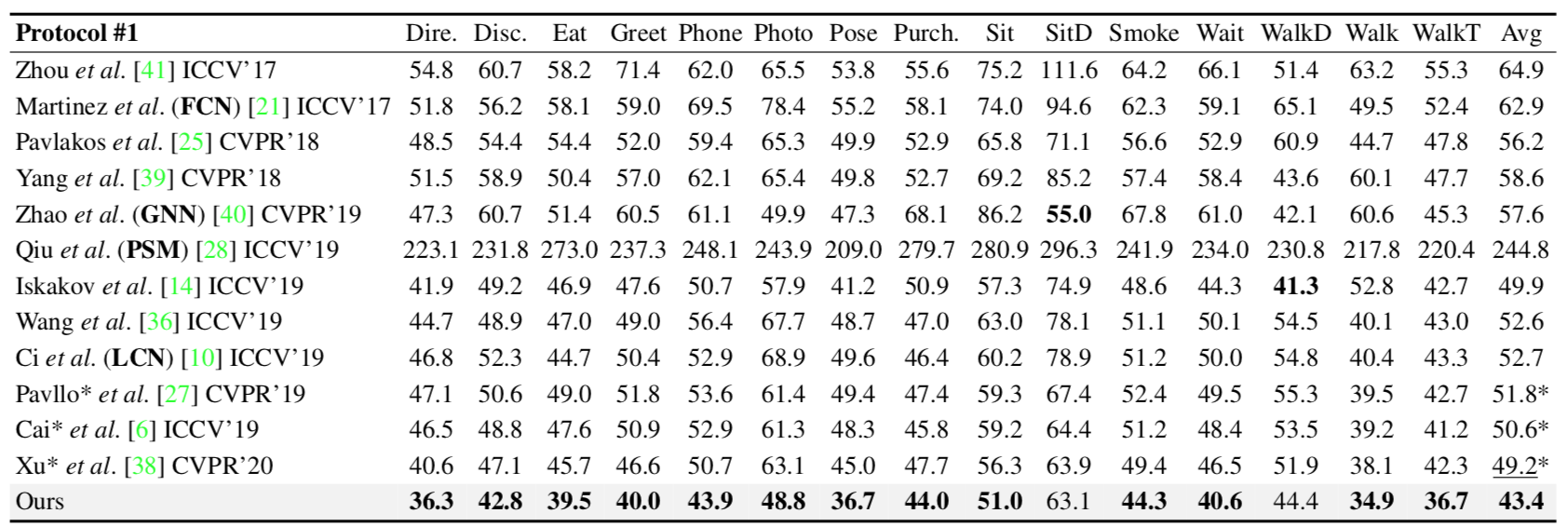This repository is the offical Pytorch implementation of ContextPose, Context Modeling in 3D Human Pose Estimation: A Unified Perspective (CVPR 2021). Below is the example pipeline of using ContextPose for 3D pose estimation.

This project is developed using >= python 3.5 on Ubuntu 16.04. NVIDIA GPUs are needed.
- Clone this repo, and we'll call the directory that you cloned as ${ContextPose_ROOT}.
- Install dependences.
- Install pytorch >= v1.4.0 following official instruction.
- Install other packages. This project doesn't have any special or difficult-to-install dependencies. All installation can be down with:
pip install -r requirements.txt
- Download data following the next section. In summary, your directory tree should be like this
${ContextPose_ROOT}
├── data
├── experiments
├── mvn
├── logs
├── README.md
├── process_h36m.sh
├── requirements.txt
├── train.py
`── train.sh
Note: We provide the training and evaluation code on Human3.6M dataset. We do NOT provide the source data. We do NOT own the data or have permission to redistribute the data. Please download according to the official instructions.
- Install CDF C Library by following (https://stackoverflow.com/questions/37232008/how-read-common-data-format-cdf-in-python/58167429#58167429), which is neccessary for processing Human3.6M data.
- Download and preprocess the dataset by following the instructions in mvn/datasets/human36m_preprocessing/README.md.
- To train ContextPose model, you need rough estimations of the pelvis' 3D positions both for train and val splits. In the paper we use the precalculated 3D skeletons estimated by the Algebraic model proposed in learnable-triangulation (which is an opensource repo and we adopt their Volumetric model to be our baseline.) All pretrained weights and precalculated 3D skeletons can be downloaded at once from here and placed to
./data/pretrained. Here, we fine-tuned the pretrained weight on the Human3.6M dataset for another 20 epochs, please download the weight from here and place to./data/pretrained/human36m. - We provide the limb length mean and standard on the Human3.6M training set, please download from here and place to
./data/human36m/extra. - Finally, your
datadirectory should be like this (for more detailed directory tree, please refer to README.md)
${ContextPose_ROOT}
|-- data
|-- human36m
| |-- extra
| | | -- una-dinosauria-data
| | | -- ...
| | | -- mean_and_std_limb_length.h5
| `-- ...
`-- pretrained
|-- human36m
|-- human36m_alg_10-04-2019
|-- human36m_vol_softmax_10-08-2019
`-- backbone_weights.pth
Every experiment is defined by .config files. Configs with experiments from the paper can be found in the ./experiments directory. You can use the train.sh script or specifically:
To train a Volumetric model with softmax aggregation using 1 GPU, run:
python train.py \
--config experiments/human36m/train/human36m_vol_softmax_single.yaml \
--logdir ./logsThe training will start with the config file specified by --config, and logs (including tensorboard files) will be stored in --logdir.
Multi-GPU training is implemented with PyTorch's DistributedDataParallel. It can be used both for single-machine and multi-machine (cluster) training. To run the processes use the PyTorch launch utility.
To train our model using 4 GPUs on single machine, run:
python -m torch.distributed.launch --nproc_per_node=4 --master_port=2345 --sync_bn\
train.py \
--config experiments/human36m/train/human36m_vol_softmax_single.yaml \
--logdir ./logsAfter training, you can evaluate the model. Inside the same config file, add path to the learned weights (they are dumped to logs dir during training):
model:
init_weights: true
checkpoint: {PATH_TO_WEIGHTS}Run:
python train.py \
--eval --eval_dataset val \
--config experiments/human36m/eval/human36m_vol_softmax_single.yaml \
--logdir ./logsUsing 4 GPUs on single machine, Run:
python -m torch.distributed.launch --nproc_per_node=4 --master_port=2345 \
train.py --eval --eval_dataset val \
--config experiments/human36m/eval/human36m_vol_softmax_single.yaml \
--logdir ./logsArgument --eval_dataset can be val or train. Results can be seen in logs directory or in the tensorboard.
- We evaluate ContextPose on two available large benchmarks: Human3.6M and MPI-INF-3DHP.
- To get the results reported in our paper, you can download the weights and place to
./logs.
| Dataset to be evaluated | Weights | Results |
|---|---|---|
| Human3.6M | link | 43.4mm (MPJPE) |
| MPI-INF-3DHP | link | 81.5 (PCK), 43.6 (AUC) |
- For H36M, the main metric is MPJPE (Mean Per Joint Position Error) which is L2 distance averaged over all joints. To get the result, run as stated above.
- For 3DHP, Percentage of Correctly estimated Keypoints (PCK) as well as Area Under the Curve (AUC) are reported. Note that we directly apply our model trained on H36M dataset to 3DHP dataset without re-training to evaluate the generalization performance. To prevent from over-fitting to the H36M-style appearance, we only change the training strategy that we fix the backbone to train 20 epoch before we train the whole network end-to-end. If you want to eval on MPI-INF-3DHP, you can save the results and use the official evaluation code in Matlab.
If you use our code or models in your research, please cite with:
@article{ma2021context,
title={Context Modeling in 3D Human Pose Estimation: A Unified Perspective},
author={Ma, Xiaoxuan and Su, Jiajun and Wang, Chunyu and Ci, Hai and Wang, Yizhou},
journal={arXiv preprint arXiv:2103.15507},
year={2021}
}
This repo is built on https://github.com/karfly/learnable-triangulation-pytorch. Part of the data are provided by https://github.com/una-dinosauria/3d-pose-baseline.



